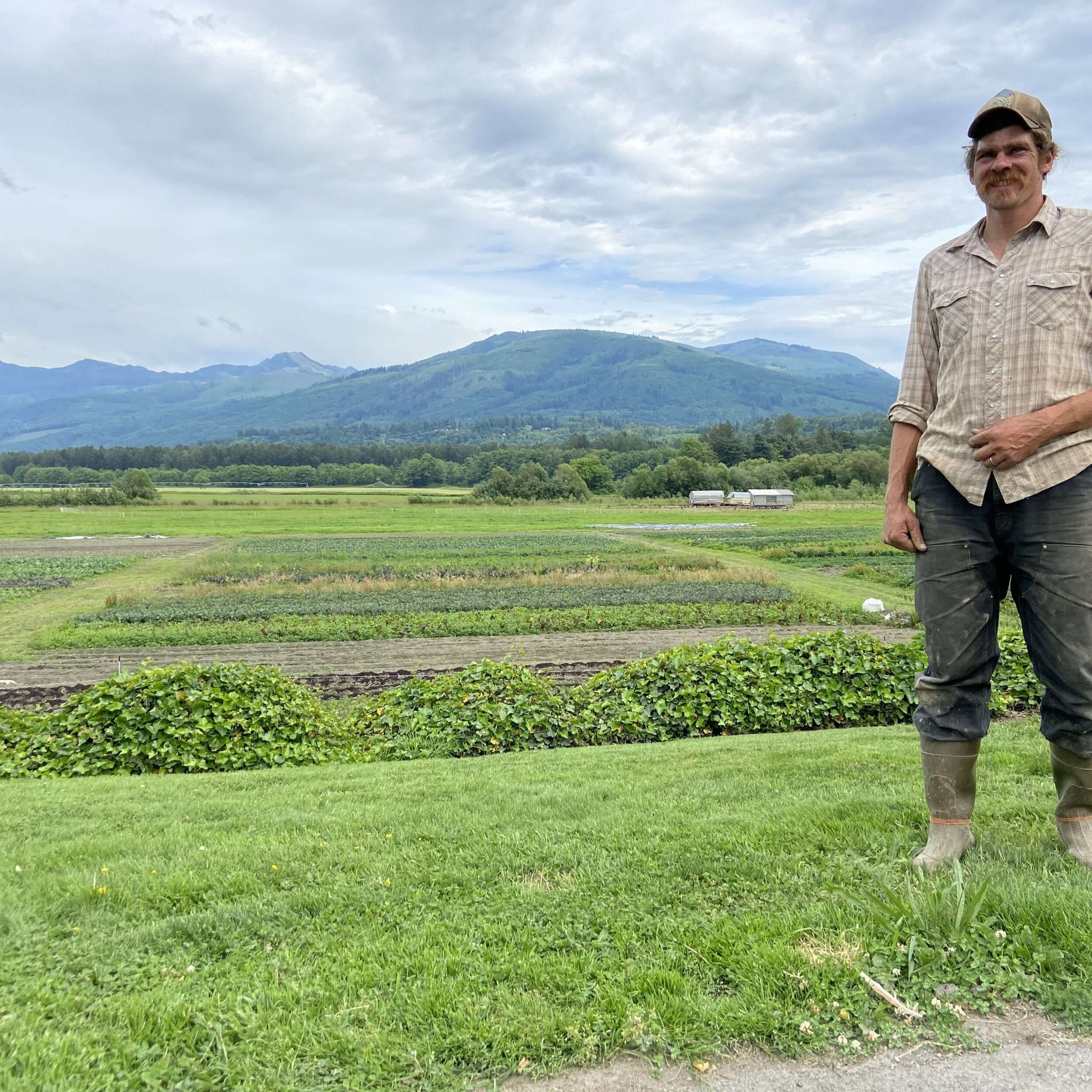From Ski Bum to Regenerative Farmer
“First you grow the soil. . . This is the right way that I wanted to farm.”
Matt Steinman didn’t plan to become a farmer. The 38-year-old self-described former “ski bum” spent his 20s working as a ski patroller, with seasonal odd jobs to survive. But when he rented a house outside of Bellingham in 2009 with a patch of garden space, it lit a spark – and everything changed.
Steinman was soon growing more food than he could eat, and started giving produce away to friends. One thing led to another, and he eventually was running a produce operation from his back yard, creating and selling 15 boxes of produce per week.
The landlord eventually said “no more,” Steinman said with a laugh, putting a stop to his unofficial CSA.
Undaunted, Steinman set his sights on the property where he grew up, just east of Sedro-Woolley, at the time being used by his family as horse pasture. He started out growing food on a small corner of the pasture the first year, and, in an ongoing turf battle with the horses, has now expanded to 12 acres, with more growth planned.
“I can’t keep up with the demand,” he said, standing over rows of Asian greens, kale and cabbage. “People want to know where their food is coming from.”
Steinman’s “Foothills Farm” is named after the foothills of the North Cascade Mountains that surround the property, located in what is known as the Skiyou area, several miles east of Sedro-Woolley. Hanson Creek, a salmon-bearing stream, runs along the west side of Steinman’s property. The Skagit River is just under a mile away, across rich bottomland fields, behind a wall of towering cottonwoods.
Steinman, who is 6’ 6” tall, still has a bit of boyish ski bum about him, with curly blond locks and a shaggy beard. But these days, he’s all about growing high-quality food in the best possible way for the environment. And that, in turn, means a lot of careful planning and hard work.
Foothills Farm has found a successful niche by personally selling his produce at five Farmer’s Markets in three Seattle Farmers’ Markets – Queen Anne, Ballard and Bellevue, as well as the Bellingham and Sedro-Woolley Farmers Market. He’s grown a cult following for his large, rich, eggs, which sell for $8-$9 a dozen.
The eggs are the product of Steinman’s 800 chickens, fed on local grain he ferments at his farm. The chickens are free-range pastured on his land, which, in addition to an average of 350 eggs per day with beautiful orange yolks, provides soil nutrients as well as soil-scratching and pest-eating “services” for Steinman’s produce operation. Steinman typically sells about 30 different crops at a time, aiming for as many different options as he can so as to lure customers away from grocery stores to his farmers’ market stand.
One of Foothill Farm’s most popular items is the “salad bar.” Rather than the typical salad mix that most farmers have pre-bagged at their stands, Steinman allows customers to choose from a variety of different interesting greens, such as salanova lettuce, baby mustard greens, mizuna, arugula, baby kale and tatsoi.
Because Steinman personally sells his food at the market stands, he’s able to connect directly with his customers – explaining different produce, giving cooking suggestions, and telling them just how his products are grown. He’s also able to capture more of a profit by mostly selling at retail prices rather than wholesale.
Keeping a variety of produce consistently available year round is a huge planning feat, starting with seeds in hoop houses and methodical crop rotation plans that rival large farms. He works 7 days a week, many times heading out to the fields before his two young girls wake up, coming home after dark. It’s old-school farming.
Foothills Farm is beyond what he calls “conventional organic,” which in some ways is like conventional farming with substituted products. Steinman, on the other hand, has created an intricate, integrated system that avoids herbicides, pesticides and introduced nutrients, and includes a broad range of activities like preparing soil with chickens, mounding garden beds, fire-torching weeds, mulching, on-farm composting, and very limited tilling, which keeps soil and worms intact as much as possible.
“First you grow the soil,” he said as he knelt down at one of his beds and let the loose, dark-brown soil run delicately through his hand. “This is the right way that I wanted to farm.”
The practice is called regenerative farming, which focuses on rehabilitation of the soil, topsoil regeneration, improvement of the water cycle, resilience to climate change, increased biodiversity, and onsite use of waste products such as chicken manure.
Steinman doesn’t limit his ambitions to his own farm. He’s hoping his neighborhood will convert more five and ten-acre plots of land into small farms like his, rather than just lawns or fields. His dream is to create a cooperative of like-minded small farmers in the area to feed the region.
“I have some pretty lofty ideas,” he joked.
Steinman said that Covid-19 has really amplified the demand for locally grown food. People are realizing food security is important, he said, and are developing relationships with farmers rather than buying food from across the globe. Steinman calls it “food sovereignty,” and hopes the Skagit Valley will continue to become more self-sufficient.
Steinman sees the pandemic as an opportunity for people to change their habits. “This is a moment this can happen,” he said. He also hopes to expand into a CSA again.
This time, officially.
Story and photos by Tahlia Honea: info@skagitonians.org



